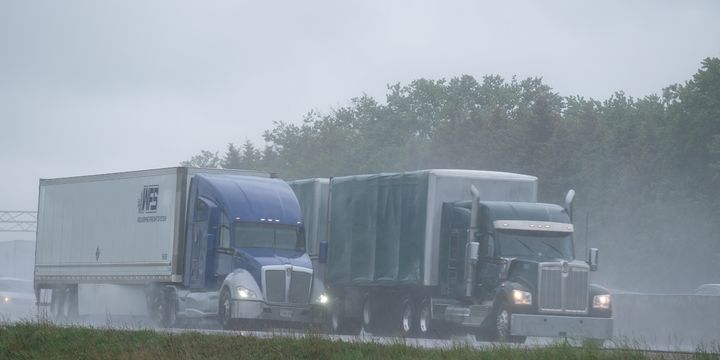Photo: Jim Park
Splash and spray can reduce driver visibility from 1,500 feet on dry road to 300-600 feet in rainy conditions, TMC says.
Spray from trucks has been irritating motorists since the 1960s.
Congress took up the challenge with the Surface Transportation Assistance Act of 1982, which contained wording requiring improvements to visibility on wet roadways by reducing splash and spray from trucks by “practicable and reliable means.” Despite decades of testing and evaluation of emerging technology, that mandate remains unfulfilled.
That’s not to say there hasn’t been improvements. Enhancements to tractor-trailer aerodynamics have streamlined the airflow around trucks, taming some of the turbulent air that propagates spray around the vehicle. But the root causes of splash and spray remain.
Standing water on highways will be picked up and tossed around by the tires, and every droplet of water flung into space smashes against some solid surface on the truck, exploding into the mist and spray that reduces visibility for nearby motorists.
The American Trucking Associations’ Technology & Maintenance Council published a recommended practices document in 2015 (RP 759) that discusses the causes and impacts of road spray and even maintenance considerations related to corrosion and dirt infiltration. It also identifies road spray hot spots, such as the tractor-trailer gap, mirrors, reefer fuel tanks, fenders, mudflaps, and even the design of the trailer skin. However, the RP doesn’t make specific recommendations for splash and spray suppression short of suggesting fleets look for ways to reduce mist-inducing turbulence.
“Splash and spray, ironically, provides a great visual indicator of the impact of vehicle aerodynamics improvements,” says Daryl Bear, the lead engineer and chief operating officer of Mesilla Valley Transportation’s research division, MVT Solutions. “You can see the spray. All that water is trapped in the swirling air around the truck. Compare the spray patterns on a square-nose non-aero truck to a fully treated truck and the difference is amazing.”

Slotted mudflaps reduce spray from the wheels by allowing water to collect and flow back to the ground rather than smashing the droplets into mist against hard rubber. Shown: Conventional mudflaps (top) versus slotted mudflaps. Photo: Eco Flaps
Bear has done tests at MVT’s facility in Las Cruces, New Mexico, quantifying the difference. Not surprisingly, trailer side skirts help a lot. Front and rear-end treatments help as well.
“Smoothing out the air flow and reducing turbulence is one thing, but the side treatments keep the spray out from under the truck where all the square surfaces are, like axles, crossmembers and the landing gear,” he says. “And mudflaps appear to matter a great deal, too.”
He found that slotted mudflaps, such as Eco Flaps, allow air to pass through, while trapping water droplets and allowing them to drain back to the pavement — rather than splattering into a finer mist as they would against a hard solid surface.
“We market the Eco Flaps as fuel-saving devices, but they have safety benefits too, through improved visibility both for the truck driver and other motorists,” says Asa Hazelwood, Eco Flaps’ president.
There are other brands available, such as Aeroflap from Fleet Engineers, Michelin’s Energy Guard, and Featherwing SprayBreaker flaps.
Slotted mudflaps are one of many attempts at reducing splash and spray. There are also textured mudflaps that look a bit like AstroTurf. There are broom-like spray suppression skirting from the likes of Fleet Engineers mounted above drive and trailer axles designed to keep water from the wheels from escaping into the slipstream. These and other technologies have some impact on spray, but not all fleets see the value in installing them.
“Trucks need mudflaps,” Hazelwood says. “They will see a [return on investment] on our product from fuel savings. There’s a safety benefit too, but we hardly ever have anyone looking to buy on the safety benefits alone.”
by Jim Park
Source: https://www.truckinginfo.com/




